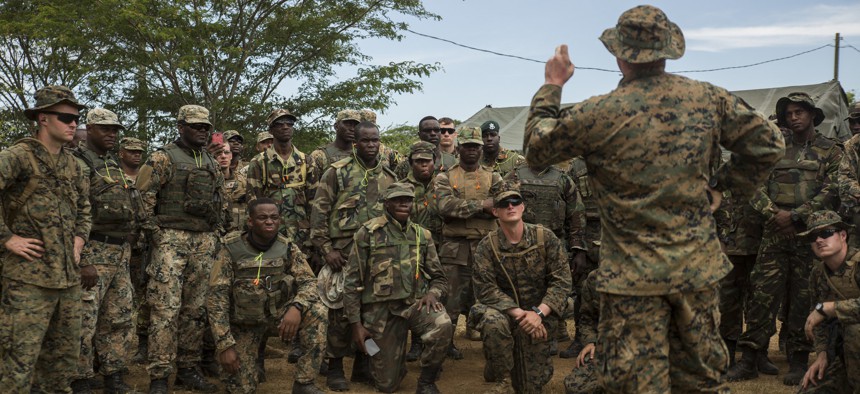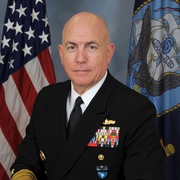
Lance Cpl. Jackson Clark, teaches a class about how to load and operate the M32 grenade launcher during Exercise Tradewinds 2016 in Jamaica. Tradewinds focuses on increasing regional cooperation in complex multinational security operations. U.S. Marine Corps, Cpl. Justin T. Updegraff
Transnational Criminals Move at Network Speed. At SOUTHCOM, We’re Learning to Do the Same
But this sea change must be matched by U.S. and foreign partners, writes the leader of U.S. Southern Command.
U.S. Southern Command is undergoing a sea change in the way we think about, analyze, and address national security concerns. Long focused on countering illicit trafficking, we have advanced our understanding of the complexity of threats that affect our operating environment. In consultation with our international allies, interagency partners, and U.S. embassies in Latin America and the Caribbean, we are working to ensure the long-term stability of the hemisphere and security of our southern approaches by helping our law enforcement partners dismantle transregional and transnational threat networks.
USSOUTHCOM’s actions during last summer’s Operation Citadel are but one illustration of this collaborative approach. Led by the Department of Homeland Security, the multinational and interagency effort resulted in the arrest of 41 people on charges related to smuggling hundreds of people into the United States. Each was linked to transnational criminal organizations operating in South and Central America. As with many operations, the arrests yielded valuable information about other networks — in Asia, Africa, Europe, and the Middle East — that help smuggle people into the United States. One of the major takeaways from the operation is that, contrary to many long-held opinions, these networks do indeed work together at multiple levels and their efforts are often closely coordinated. While they typically have independent leadership, the groups consistently use the same web of enablers (document forgers, logisticians, safe houses, etc.) to move their products.
The revelations from Operation Citadel underline two major themes that are driving the evolution of our thinking here at SOUTHCOM. First, these organizations are vast, interconnected, technologically savvy, well-funded, and comprised of ruthless criminals who traffic in myriad illicit commodities. They move product and people with ease through existing pathways in the Western Hemisphere to almost anywhere, at any time. Whether they traffic in drugs, people, counterfeit goods, intellectual property, or weapons, our major concern is not the product being moved or, for that matter, the demand signal for the product. These illicit flows – and the violence and corruption these flows introduce at home and abroad – are just the visible manifestation of the amorphous, highly adaptable networks that have firmly embedded themselves in the fabric of our societies. The illicit networks, enabled by their freedom of movement across borders and entire regions, are the real threat; not the commodities they move. Here at SOUTHCOM, we are illuminating the pathways these networks use to help us find ways to stem the product flow, regardless of the commodity being moved.
The second major theme we extract from Operation Citadel is the need to think differently and creatively. This goes beyond simply gaining a better understand of the adversaries we face. It also applies to our “friendly networks”: the U.S. government and our fellowship of partner nations and allies. We would all benefit from a better understanding of one another. While we are integrated well in certain areas, we can always do better. Different players have different pieces of the puzzle, but it is not always clear how those pieces fit together, especially as we try to conduct deep analysis of how the “not-so-friendly” networks operate and interact. We have glimpses of the illicit financial flows, a partial understanding of the centrality of particular routes and nodes, an expanding knowledge base about how threat networks function, and a shared recognition that corruption is a huge part of the problem that allows networks to flourish. We also have a nagging sense that we are using twentieth century approaches to fight 21st-century threats.
Broadly speaking, everyone in the “friendly network” knows what needs to be done. We need to increase regional cooperation, real-time information sharing, and multi-national operations. We need to continue building and reinforcing bonds of trust across and between our own military, law enforcement, diplomatic, and intelligence communities; and, more importantly, fuse these bonds bilaterally and multilaterally with our key partners. We must also continue to explore innovative technologies that not only make us smarter, they make us better.
Gaining a better understanding of the intertwined nature of these networks is our biggest challenge. We have, at best, an incomplete picture of how this all fits together. To remedy this, we need to ask the right questions: How do the social bonds between individual actors connect broader networks to one another? How are key facilitators sought out and put to use? How does one criminal activity – say, the trafficking of several thousand kilos of cocaine from South America to Europe – transform along the value chain into funding, capabilities, or support for the widely disparate licit and illicit networks scattered across the globe? Operation Citadel revealed some answers, but I contend that not enough of us appreciate, or are even aware of, the threat we face.
These are questions that all of us – within and across mission sets, whether counterterrorism, counter-TOC, or counterdrug – need to be asking. At USSOUTHCOM we are lifting our sights from a limited focus on a single illicit commodity – drugs – and instead asking ourselves what this networked threat means to everything we do and say. The motivations of transnational criminal groups and violent extremist organizations may be diverse and distinct, but no matter what form a network takes, there are fundamental similarities in how they operate, how they thrive, and how they survive our attempts to disrupt them. If we can inculcate this key point, we can begin to understand the networks, and, more importantly, learn how to degrade and dismantle them.
Make no mistake, USSOUTHCOM is already doing critical work to help protect our nation. Our total force of soldiers, sailors, airmen, Marines, Coast Guardsmen, and civilian employees have long been confronting these networks and building our partners’ capability to do the same. While each kilo seized, boat intercepted, or human-smuggling-operation disrupted is a victory, we have to think more strategically. To keep our nation safe, we must move past simple synchronization and collaboration toward a complete understanding and integration. We have been charged with defending our nation’s southern approaches, by orienting our thinking towards the networks that threaten the United States. The time has come to better integrate our disparate efforts into a faster, flatter, and more agile network of diplomatic, law enforcement, intelligence community, and military teammates.
NEXT STORY: Can Trump Make a Deal With North Korea?
